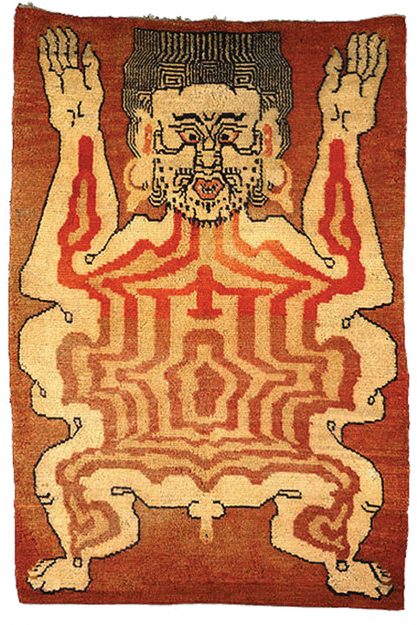In the visual language of Tibetan Buddhism, fearsome images are often metaphors for transformation. A lucid reading of a few such images was provided in “Rugs and Ritual in Tibetan Buddhism,” a small but revelatory exhibition of Tibetan ritual art organized by John Guy, curator of south and southeast Asian art at the Metropolitan Museum of Art in New York City.
At the center of the show, which ran through June of this year, was a group of unusual 19th-century Tibetan carpets portraying flayed animals and people, severed heads, and demonic figures. Accompanying them was a modest grouping of sculptures, ritual implements, and paintings. All of the objects were once used by Vajrayana Buddhist practitioners in rituals associated with the worship of wrathful protective deities.
An esoteric form of Buddhism, Vajrayana emerged as a school around the middle of the first millennium C.E. and reached its highest expression in Tibet between the 8th and the 20th centuries. It is characterized by the extensive use of ritual activities—among them the initiation of the practitioner by an authorized master, the visualization of oneself as a deity, the recitation of mantras, and the making of offerings—all designed to remove obstacles on the path to enlightenment.
The exhibition at the Met opened with a photograph, taken in 1921, of a Tibetan lama performing invocations. Around him can be seen examples of some of the implements included in the show. They are rather alarming objects. Although Tantric Buddhism evolved out of the altruistic bodhisattva path of Mahayana Buddhism, its iconography is drawn from the realms of the battlefield and the cremation ground (a favored meditation spot for early tantric yogis), as well as from Tibet’s pre-Buddhist religion, Bon, which is heavily influenced by shamanism.
Works on the gallery’s walls (fittingly painted blood-red) included an extraordinary 16th-century cloth painting depicting offering bowls full of brains, eyeballs, and tongues. Display cases held utensils such as a cup in the form of the top half of a human skull and choppers for the symbolic cutting up of flesh. Potent images of bodily dissolution, they represent the annihilation of the self-cherishing ego and its five poisons—ignorance, desire, hatred, pride, and jealousy—that is the aim of advanced Buddhist practice.
Even more startling were the carpets bearing images of flayed human beings, tigers, and an elephant, representing the destruction of desire, hatred, and ignorance respectively. The rugs may have been used as meditation seats, offerings to the deities, or platforms for ritual implements. Photographs taken by the British adventurer Frederick Spencer Chapman in 1936 and 1937 show a similar carpet being used as an effigy in a Tibetan New Year’s ceremony.
The rather rigid formulas that dictate the composition, color, and proportions of much Tibetan ritual art seem to have been relaxed in these carpets, which evince an uncommon degree of formal inventiveness and individual expression. The figures in them are likewise full of life and individuality; in some cases they may have been endowed with distinct personalities in order to divert harmful forces from families or communities.
 Skinned and floating in a sea of blood, a rather louche-looking man in one carpet has wide dark eyes, high cheekbones, and full lips, pursed in a scowl. His stubbly cheeks are in marked contrast to the neatly trimmed moustache and beard—matched by a little tuft of pubic hair—of another flayed man, hung by his wrists in a rug nearby.
Skinned and floating in a sea of blood, a rather louche-looking man in one carpet has wide dark eyes, high cheekbones, and full lips, pursed in a scowl. His stubbly cheeks are in marked contrast to the neatly trimmed moustache and beard—matched by a little tuft of pubic hair—of another flayed man, hung by his wrists in a rug nearby.
Particularly charming are two carpets featuring tiger-skin designs. In 19th-century Tibet, such rugs were a replacement for actual tiger pelts from India, which were scarce by the late 1800s. Although they had secular uses as seats for high officials, full tiger skins were a traditional part of a yogi’s essential equipment.
In the first of these mats, a rich purplish-brown tiger pelt is framed by a decorative, red saw-tooth border representing the bloody edges of the cat’s speckled underbelly. In spite of being freshly skinned, the animal seems to quiver with tension from twitching nose to switching tail. In the second rug, the artist has cleverly used variegations in the burnt umber and burnt sienna wool to create the illusion of three-dimensionality, even as the tiger itself, double-headed and extending off the sides of the carpet, seems to be dissolving into an allover pattern of interlocking, bow-shaped marks.
Small is sometimes better. With a minimum of means, this show unpacked the meaning of these beautiful, powerful, and mysterious objects, even as it celebrated them as thrilling works of art.